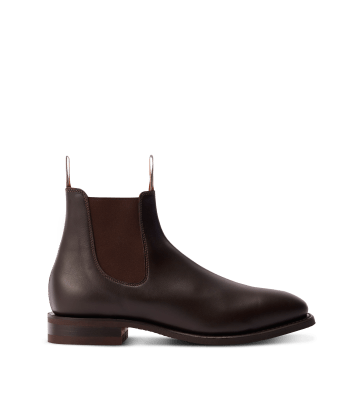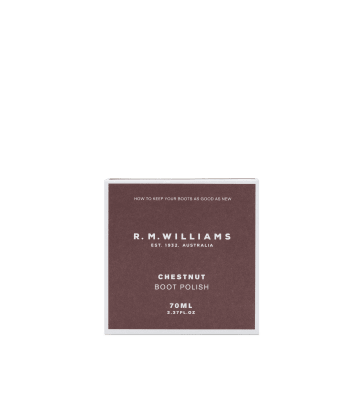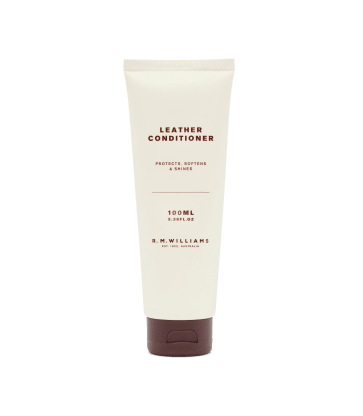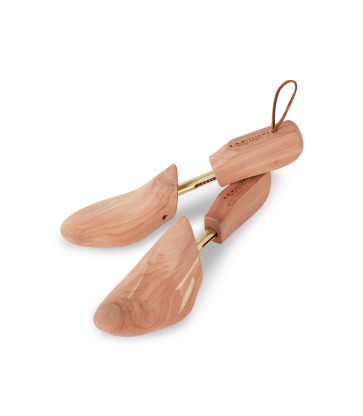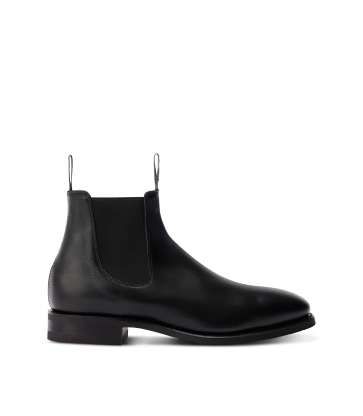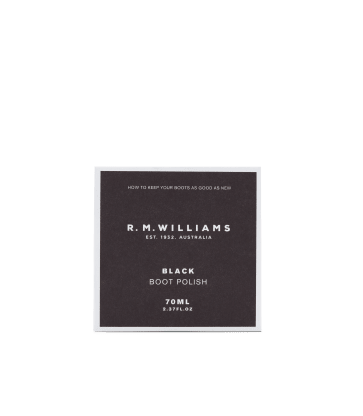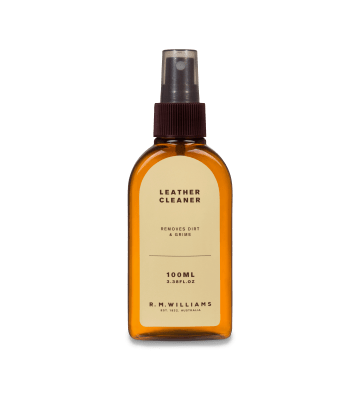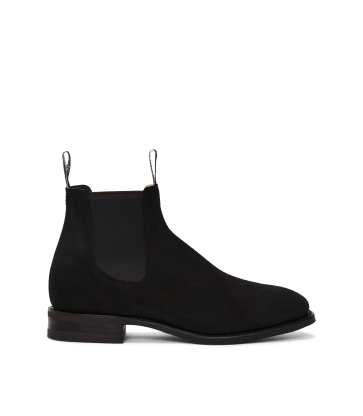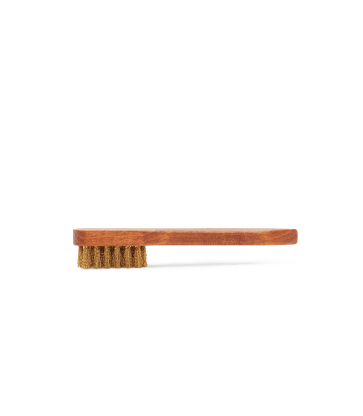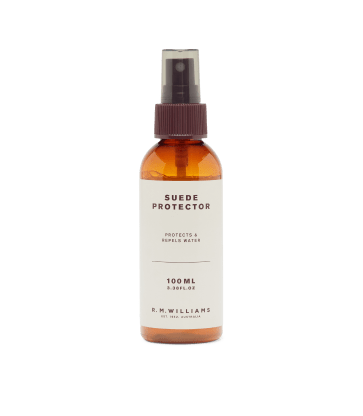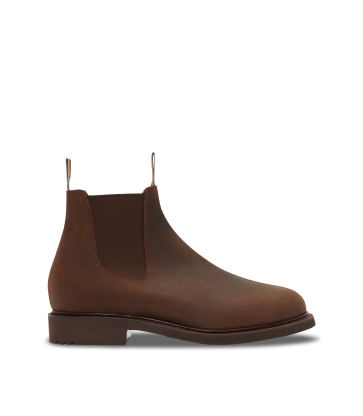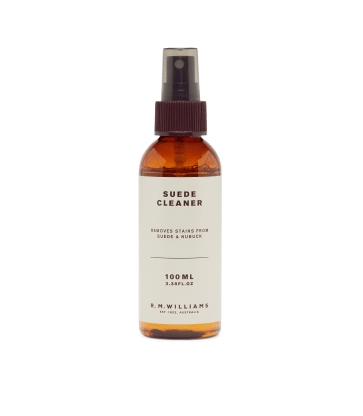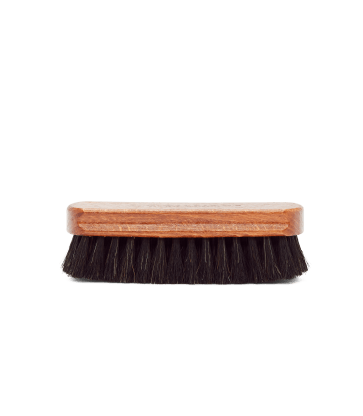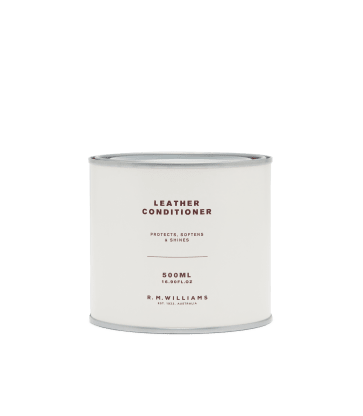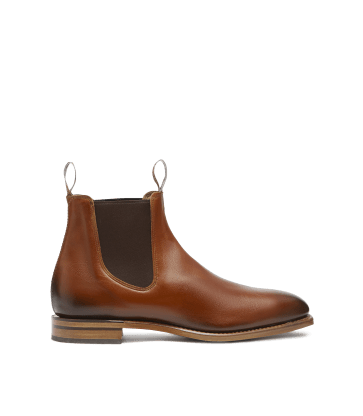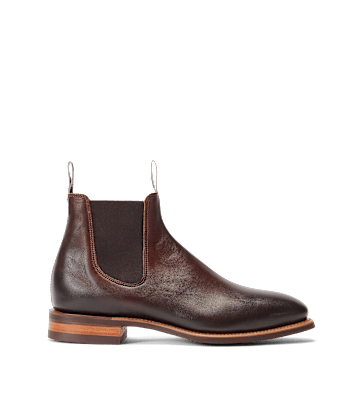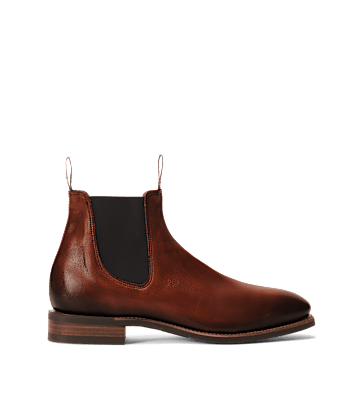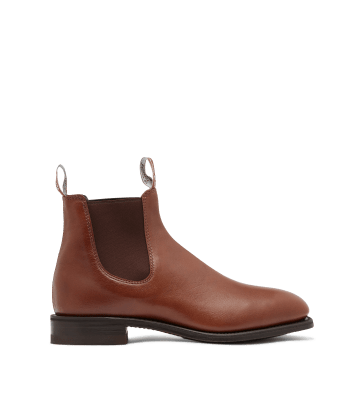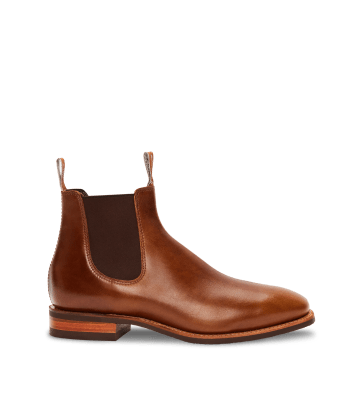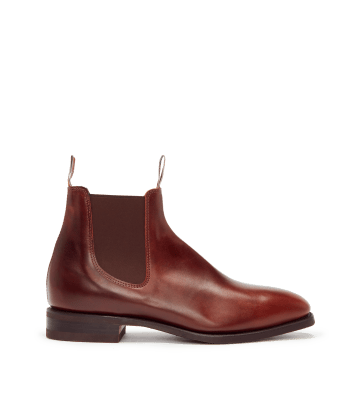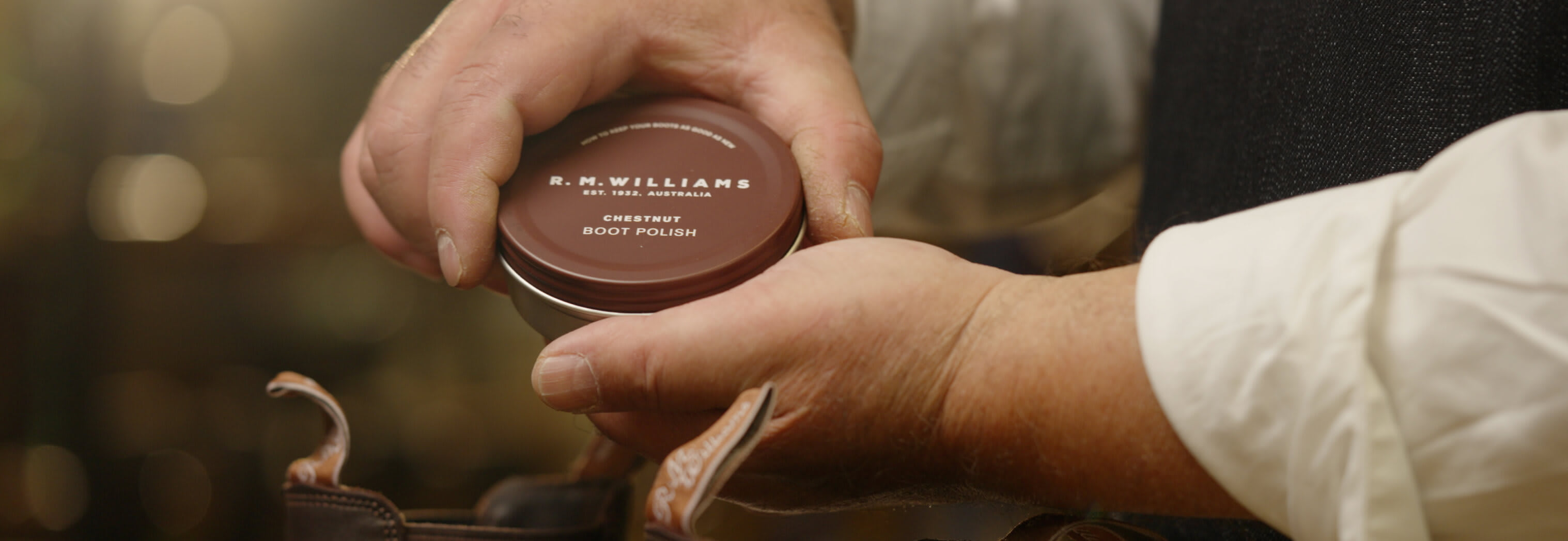
How to maintain your boots - Care Guides
An investment, not a purchase
Pigmented finished leathers | Suede or nubuck leathers | Greasy kip / oily leathers | Burnished leathers | Aniline leathers | Pull up leathers
Caring for pigmented finished leathers
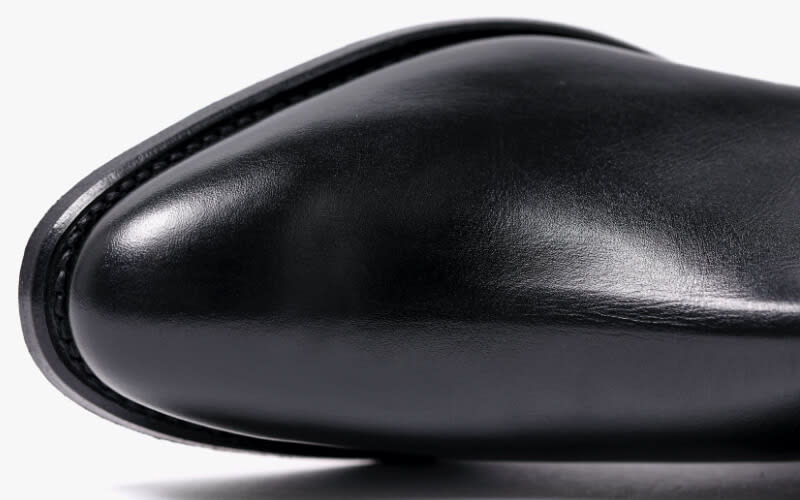
Pigmented finished leathers include
Yearling, veal calf, willow, kangaroo black and chestnut, ostrich black, crocodile
Pigmented finished leathers
Leathers with a pigmented finish (e.g. yearling, veal calf, crocodile) undergo a process that involves the application of pigments and protective coatings to the surface of the hide. This finishing method creates a smooth, uniform and consistent appearance, concealing the natural variations in the leather's texture and colour.
Cleaning
R.M.Williams Leather Cleaner is specifically formulated to remove dirt and grime from leather boots, shoes and accessories.
1. Wipe the boot with a damp cloth to remove surface mud, dirt, dust or salt.
2. Apply R.M.Williams Leather Cleaner directly onto any excessive marks in the leather and rub evenly over the surface with a damp cloth until clean.
3. Remove any excess cleaner with a dry clean cloth.
Conditioning
R.M.Williams Leather Conditioner should be applied regularly to pigmented finished leather footwear to maintain and preserve the leather, preventing it from drying out or cracking.
1. Apply R.M.Williams Leather Conditioner evenly to pigmented finished leathers with a clean cloth or hands.
2. Allow the conditioner to penetrate leather for approximately one hour.
Note: Be careful not to over condition; leather also needs to breathe. We recommend conditioning your leather boots every 2-3 months, no matter how often you clean or polish them.
Polishing
Use R.M.Williams Stockman’s Boot Polish regularly to maintain the colour of your boots, remove scuffs and keep them looking fresh.
1. Apply R.M.Williams Stockman’s Boot Polish to finished leathers with a clean cloth or brush and rub in well.
2. Allow polish to rest on surface and penetrate leather for a minute.
3. Buff surface thoroughly with a shoeshine brush and finish with a buffing cloth to obtain a high shine.
Note: For badly scuffed boots, leave the polish on the uppers overnight to ensure the pigment is absorbed into the leather.
Related products
Caring for suede and nubuck leathers
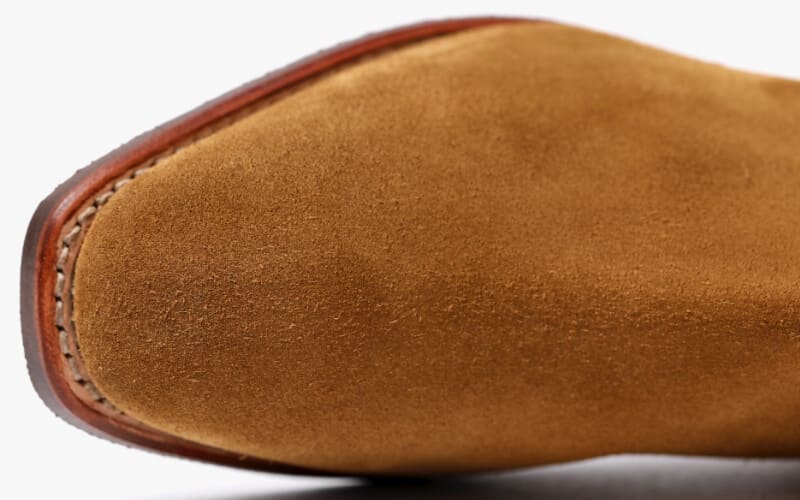
Suede and nubuck leathers include
Suede, nubuck, desert kip, roughout suede, crazy horse, distressed
Suede and nubuck leathers
Suede and nubuck are distinct types of leather finishes known for their soft and luxurious textures. Both suede and nubuck leathers have a nap which is created by sanding or buffing the hide's surface to create raised fibres. The key difference between the two leather types is the side of the hide that is sanded or buffed to create the texture.
Suede comes from the inner/under layer of the hide and has a soft, fuzzy nap.
Nubuck comes from the outer/surface layer of the hide and retains a slight grain pattern with a short velvety nap.
Note: For nubuck, crazy horse and distressed leathers the blocking line that runs down the middle of the boot is often more noticeable in oily leathers due to the wax/oil content. The blocking line is a characteristic hallmark of the blocking process, an integral step required to make a boot out of one piece of leather. Due to the individual nature of leather, each hide will block differently, and the appearance of the blocking line differs across all boots and leather types. The blocking line is likely to fade over time (it may not completely go away) but it is a visual sign of quality and should be worn with pride.
Protecting
When used regularly, R.M.Williams Suede Protector will create a durable and breathable layer, protecting suede and nubuck leathers from water and stains that occur with regular wear.
1. Prior to first wear, spray R.M.Williams Suede Protector onto clean footwear, in one direction, at a distance of 20cm.
2. Allow to dry naturally, avoiding direct heat.
3. Spraying in the opposite direction, repeat this process for a total of 3 times to ensure maximum coverage.
Note: Be mindful of wearing jeans or trousers that are non-colour fast over lighter coloured suede or nubuck boots as the colour may transfer to the leather.
Note: We recommend protecting your leather boots with suede protector every 2-3 months, to help maintain and increase longevity of water resistance.
Cleaning
R.M.Williams Suede Cleaner is specifically formulated to lift marks from suede or nubuck leathers.
1. Gently brush the suede with a suede brush.
2. Spray Suede Cleaner onto a clean cloth or sponge and work cleaner in a circular motion onto surface of boot. If you have any stubborn marks on your suede boots, focus your brushing and cleaner spray on this area.
3. Dab the shoes with a clean towel to remove any excess moisture and leave to dry naturally, avoiding direct heat.
4. Once dry, brush up nap with a suede brush to remove marks. It can be hard to get every mark out of suede, but any remaining will add to the character of your boots.
5. Re-apply R.M.Williams Suede Protector using the same method above.
Note: If you do get wet mud on suede boots, let it fully dry first. Then brush gently using a suede brush.
Note: Suede brass bristle brush and suede cleaner is for use on suede leather only.
Related products
Caring for greasy kip
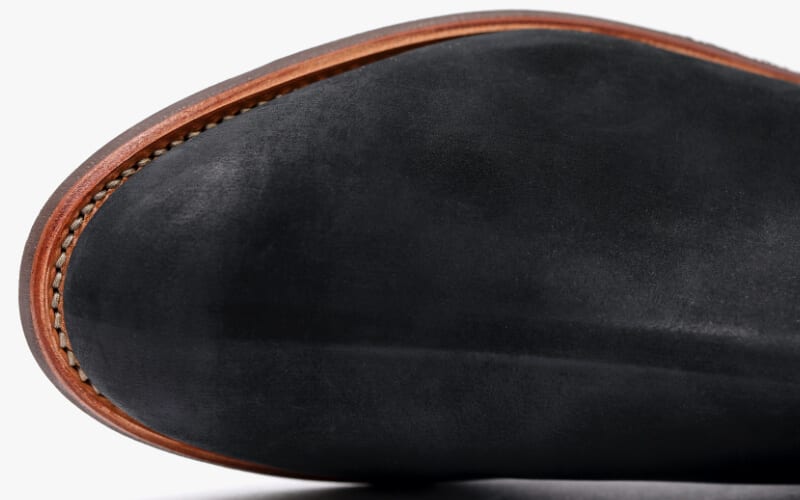
Greasy/Oily leathers include
Greasy kip, oily, vesta
Greasy/Oily leathers
"Greasy" or "oily" leather has been treated with oils and waxes during the tanning process.
The primary purpose of treating leather with oils and waxes is to enhance its durability and weather resistance. The oils and waxes penetrate the leather fibres, providing a protective barrier that helps repel water and resist damage from environmental elements. This makes greasy or oily leather particularly suitable for outdoor, wet weather or rugged wear.
The treatment of oils and waxes imparts specific characteristics to the leather, making it distinct from other types of leather.
Note: The blocking line that runs down the middle of the boot is often more noticeable in oily leathers due to the wax/oil content. The blocking line is a characteristic hallmark of the blocking process, an integral step required to make a boot out of one piece of leather. Due to the individual nature of leather, each hide will block differently, and the appearance of the blocking line differs across all boots and leather types. The blocking line is likely to fade over time (it may not completely go away) but it is a visual sign of quality and should be worn with pride.
Conditioning
R.M.Williams Leather Conditioner should be applied to greasy/oily leather footwear to maintain and preserve the leather, preventing it from drying out or cracking.
1. Apply R.M.Williams Leather Conditioner evenly to greasy/oily leathers with a clean cloth or hands.
2. Allow the conditioner to penetrate leather for approximately one hour.
Note: Be careful not to over condition; leather also needs to breathe. We recommend conditioning your leather boots every 2-3 months, no matter how often you clean them.
Note: Do not use Stockman’s Boot Polish on greasy kip or oily leathers, as it drastically changes the appearance of the boots.
Related products
Caring for burnished leathers
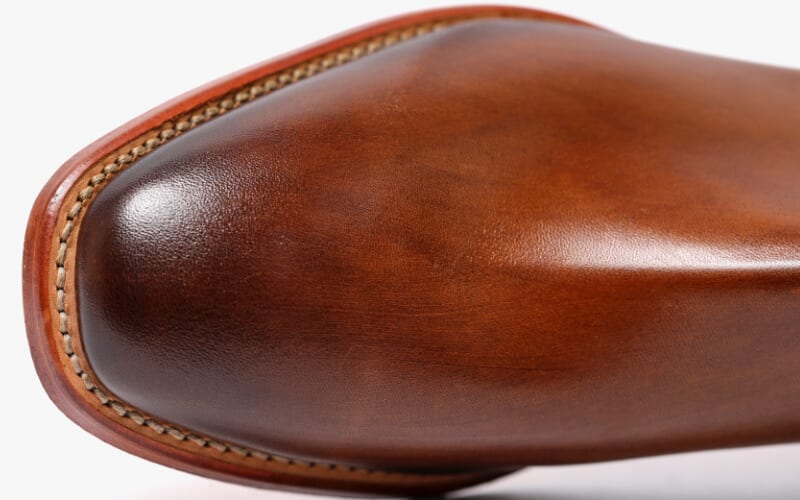
Burnished leathers include
Burnished
Burnished leathers
In the burnishing process, a coloured dye is applied by hand onto an unfinished crust leather. Burnished leather boots will develop a patina and aged look over time with wear. This is a natural process that enhances its unique appearance.
With every wear, you will add individual character and style to this leather. It’s worth looking after your boots well to retain their unique finish.
Cleaning
Get the best out of your boots by keeping them clean. If you look after your boots, they’ll look after you.
1. Only clean surface lightly with a damp cloth.
Note:DO NOT apply leather conditioner, cleaner or coloured polish as this will drastically alter the natural finish and burnished features of the leather.
Note: Avoid using solvents or abrasive materials on burnished leather boots, as they can damage the finish and alter the colour (avoid touching boots immediately after applying hand sanitiser as the alcohol content can damage the finish and colour of the boots).
Polishing
Use R.M.Williams Stockman’s Natural Boot Polish regularly to protect and maintain the look of your boots.
1. Apply R.M.Williams Stockman’s Natural Boot Polish with a clean cloth and rub in well.
2. Allow polish to rest on surface and penetrate leather for a couple of minutes.
3. Buff surface with a buffing cloth to obtain a high shine.
Note: The first couple of times that you polish your boots, a small amount of excess dye may come off. This is natural and will not affect the overall finish.
Related products
Caring for aniline leathers
Aniline leathers include
Yearling nutmeg, yearling rum, kangaroo tanbark, ostrich brown
Aniline leathers
Aniline leathers are dyed with transparent, water-soluble dyes so that the colour penetrates all the way through the hide, giving the leather its lush and rich colour. No protective coating or surface pigmentation is applied, which keeps the natural feel and look of the hide. The leathers maintain their natural markings and texture which contributes to the authentic appearance of the leather.
Cleaning
Get the best out of your boots by keeping them clean. If you look after your boots, they’ll look after you.
1. Only clean lightly with a damp cloth.
Polishing
Use R.M.Williams Stockman’s Natural Boot Polish to protect and maintain the look of your boots. *Note - aniline leather doesn't require frequent polishing.
1. Apply R.M.Williams Stockman’s Natural Boot Polish with a clean cloth and rub in well.
2. Allow polish to rest on surface and penetrate leather for a minute.
3. Buff surface with a buffing cloth to obtain a high shine.
Conditioning
R.M.Williams Leather Conditioner should be applied sparingly and gently. With a soft, clean cloth to revive the luster of the leather. It is recommended to first test it on a small, inconspicuous area of the boot to ensure it doesn't alter the colour or texture of the leather in an undesirable way *Note - conditioner will darken the appearance of the leather.
1. Apply R.M.Williams Leather Conditioner evenly and sparingly on aniline leathers with a clean cloth or hands. Avoid concentrated areas that could lead to uneven colour or texture changes.
2. Allow the conditioner to penetrate leather for approximately one hour.
Note: Be careful not to over condition; leather also needs to breathe. We recommend conditioning your leather boots every 2-3 months, no matter how often you clean or polish them.
3. After applying the conditioner, use a clean, dry cloth to lightly buff the leather. This can help remove any excess conditioner and bring out a subtle sheen.
Related products
Caring for pull up leathers
Pull up leathers include
Pull up
Pull up leathers
Pull up leather is known for its unique colour variations and the way it changes in appearance when stretched or pulled, creating a boot with highs and lows in tone.
The 'pull up' finishing technique infuses oils and waxes into the hide. The high oil content allows for lines and marks to form in the leather when it is pulled, rubbed or flexed as the oil moves around the hide.
Pull up leather starts as aniline leather - it is treated with transparent, water-soluble dye that permeates the leather's fibres. Aniline leather does not have a pigment coating on the surface of the leather which showcases the natural texture and features of the leather. After the aniline dye is applied, pull-up leather receives an additional treatment with oils and waxes.
Cleaning
Light marks and scratches can be rubbed out of the leather by rubbing with clean, warm fingertips. This replaces the oil where it has displaced as per the 'pull up' characteristics of this leather.
1. Rubbing a very small amount of R.M.Williams leather conditioner into the mark or scratch is an effective way to remove it. *Note - this may initially darken the appearance of the leather due to the additional oils being absorbed.
Polishing
Use R.M.Williams Stockman’s Natural Boot Polish to protect and maintain the look of your boots. *Note - pull up leather doesn't require frequent polishing.
1. Apply R.M.Williams Stockman’s Natural Boot Polish with a clean cloth and rub in well.
2. Allow polish to rest on surface and penetrate leather for a minute.
3. Buff surface with a buffing cloth to obtain a high shine.
Conditioning
R.M.Williams Leather Conditioner should be applied sparingly and gently. With a soft, clean cloth to revive the luster of the leather. *Note - conditioner will darken the appearance of the leather.
1. Apply R.M.Williams Leather Conditioner evenly and sparingly on pull up leathers with a clean cloth or hands.
2. Allow the conditioner to penetrate leather for approximately half an hour and then buff using a clean, dry, soft cloth in a back and forward motion. *Note - this may initially darken the appearance of the leather due to the additional oils being absorbed.
Note: Be careful not to over condition; leather also needs to breathe. We recommend conditioning your leather boots every 2-3 months, no matter how often you clean or polish them.
